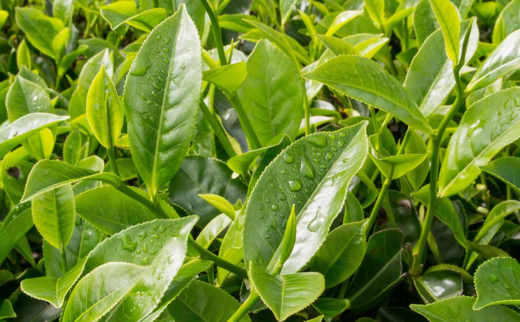The Tea Plant/ Camellia sinensis (Linn.) – Ayurvedic Uses, Benefits, Dosage & Therapeutic Actions
Abstract
Camellia sinensis, commonly known as the tea plant, is one of the most widely consumed medicinal plants globally. It serves as the source of green tea, black tea, white tea, and oolong tea, depending on the processing methods. The plant is rich in polyphenols, particularly catechins, which are known for their potent antioxidant and anti-inflammatory properties. It is traditionally used in Ayurveda and Chinese medicine, and it has a broad spectrum of therapeutic applications. Its regular consumption has been linked to improved metabolic, cardiovascular, and cognitive health. The herb holds great promise as both a preventive and curative agent in modern herbal therapy.

Introduction
The tea is made from the leaves of the Camellia sinensis plant, a species originally native to East Asia. This versatile plant grows as a shrub or small tree and is now cultivated widely across Asia, the Middle East, and parts of Africa. Camellia sinensis is a perennial, woody shrub cultivated for centuries as the primary source of common tea. It belongs to the family Theaceae. The tea prepared from Camellia sinensis offers a characteristic aroma and brisk flavour derived from its natural combination of alkaloids, polyphenols, and volatile oils. Beyond its role as a daily beverage, it holds cultural, economic, and medicinal importance, being a natural stimulant, a digestive aid, and a source of beneficial antioxidants.
Scientific Classification
- Kingdom: Plantae
- Subkingdom: Tracheobionta
- Class: Magnoliopsida
- Order: Ericales
- Family: Theaceae
- Genus: Camellia
- Species: Camellia sinensis (L.) Kuntze
Synonyms
- Chai
Vernacular Names
- Sanskrit: Syamaparni, Vishodhani
- Hindi: Chai, Chayapatra
- English: Tea plant
- Tamil: Theneer maram
- Malayalam: Chaya
- Kannada: Chaha
- Telugu: Teaku
- Bengali: Cha
- Marathi: Chaha
- Gujarati: Chaha
- Punjabi: Chai
Habitat
Camellia sinensis is native to Southeast Asia, but it is now widely cultivated in tropical and subtropical regions at altitudes of up to 7,000 feet above sea level. This adaptability explains its presence in countries like China, Cambodia, Japan, and Tibet. In India, the plant is abundantly grown in the foothills of the Himalayan ranges, as well as in regions such as Assam, Karnataka, and parts of Kerala.
Morphology
Camellia sinensis is an evergreen shrub or small tree that is pruned to waist height to facilitate harvesting. It has glossy, dark green, elliptical leaves with finely serrated margins. The leaves are leathery in texture and measure 4–15 cm in length. The plant bears fragrant, white, five-petaled flowers with numerous yellow stamens. The fruit is a small capsule containing one to four seeds. The young leaves and buds are primarily harvested for making tea.
Special Note
Different types of tea—green, oolong, and black—are produced from the same plant, with variations based on the level of fermentation. While green and oolong teas are more commonly consumed in Asian countries, black tea remains the most popular variety in the United States. Their differences can be understood by following:
- Green tea is made from unfermented leaves and retains the highest amount of natural antioxidants.
- Oolong tea undergoes partial fermentation, offering a balance between green and black tea in flavour and properties.
- Black tea is fully fermented, giving it a stronger flavour and darker colour.
Classical Categorisation
- Bhavprakash Nighantu page number 801
Ayurvedic Properties
- Taste (Rasa) – Astringent (Kashaya)
Therapeutic Properties
- Diuretic
- Astringent
- Respiratory disorders (asthma)
- Antioxidant support
- Mental alertness
Chemical Composition
1. Common to All Types of Tea:
- Polyphenols
- Catechin
- Gallocatechin
- Epicatechin
- Epigallocatechin
- Alkaloids (Caffeine, Theobromine, Theophylline)
- Flavonoids
- Purines
- Polysaccharides
- Volatile oils
- Vitamins (e.g., Vitamin C, B vitamins)
- Minerals (e.g., Potassium, Magnesium)
2. Differences Due to Processing:
- Green tea – Minimally oxidised, so it is rich in catechins (especially EGCG – epigallocatechin gallate).
- Black tea – Fully oxidised, catechins are largely converted into theaflavins and thearubigins, which change flavour, colour, and antioxidant profile.
- Normal tea (usually refers to brewed black tea) – Has the same compounds as black tea, but levels vary with brewing time and temperature.
Practical Uses
- Tea Infusion for Headache and Bad Breath: Add 1 teaspoon of tea powder to a cup of warm water and let it sit for a few minutes. Then, mix in ½ teaspoon of lemon juice thoroughly. This simple infusion helps relieve headaches and combats foul breath effectively.
- Tea Decoction for Wound Washing and Oral Care: Take 1 tablespoon of tea powder and boil it in 4 cups of water until it reduces to 2 cups. Filter the decoction and use it to wash wounds and ulcers. It is also beneficial as a mouth rinse for conditions like gingivitis and mouth ulcers.
- Herbal Tea Remedy for Vomiting and Nausea: Mix 1 teaspoon of tea powder with 5 pieces of lemon grass in 1 cup of hot water and let it steep for a few minutes. Then add ½ cup of kokum (Garcinia indica) juice and stir well. Sweeten with sugar or jaggery according to taste. This remedy is effective in managing nausea, bilious vomiting, and travel sickness.
Dosage: ½ cup, 2–3 times a day, freshly prepared, before meals. - Chewing Fresh Green Tea Leaves for Mouth Ulcers: Chewing tender green tea leaves provides quick relief from the pain and discomfort caused by mouth ulcers.
- Fresh Tea Leaf Paste for Soothing Eye Fatigue: Collect fresh, tender green tea leaves and grind them into a smooth paste. Add a small amount of rose water if desired. Apply this paste gently over closed eyelids. It helps relieve eye fatigue, stress, and exhaustion caused by prolonged screen exposure or lack of sleep.
- Herbal Green Tea for Cough, Cold, and Travel Sickness: Prepare unsweetened green tea and add a pinch of dry ginger powder along with 3–4 fresh holy basil (Tulsi) leaves. Let it steep for 2–3 minutes. Stir in ¼ tablespoon of lemon juice and strain the mixture. This remedy is beneficial for relieving an allergic cough, cold, sore throat, and motion sickness. If phlegm is excessive, add ½ teaspoon of honey before drinking.
Part Used
- Leaves
- Flowers (sometimes)
Planet Ayurveda Medicines
- Green Essential Capsules
- Green Tea
- Go-Richh Hair Conditioner
- Tulsi Green Tea
- Green Essential Gel Scrub
- Rose Toner
- Calm Easy Tea
- Diaplan Tea
- Slimolina Tea
Conclusion
Camellia sinensis is a revered medicinal plant with a long-standing reputation in both traditional and modern medicine. Its rich phytochemical profile offers numerous health benefits, ranging from improved metabolism to enhanced cognitive function. Whether consumed as a daily beverage or used in therapeutic applications, tea plays a vital role in promoting overall well-being. Its natural antioxidant and detoxifying properties make it a staple in holistic health practices. With growing scientific support, it continues to gain relevance as a functional food and medicinal herb in the 21st century.



